Abstract
Producing generality of treatment effects to new settings has been a critical concern for applied behavior analysts, but a systematic and reliable means of producing generality has yet to be provided. We argue that the principles of stimulus control and reinforcement underlie the production of most generalized effects; therefore, we suggest interpreting generalization programming in terms of stimulus control. The generalization programming procedures identified by Stokes and Baer (1977) are discussed in terms of both the stimulus control tactics explicitly identified and those that may be operating but are not explicitly identified. Our interpretation clarifies the critical components of Stokes and Baer's procedures and places greater emphasis on planning for generalization as a part of training procedures.
Keywords: generalized effects, generalization programming, maintenance, quantal interpretation, stimulus control, stimulus generalization
Full text
PDF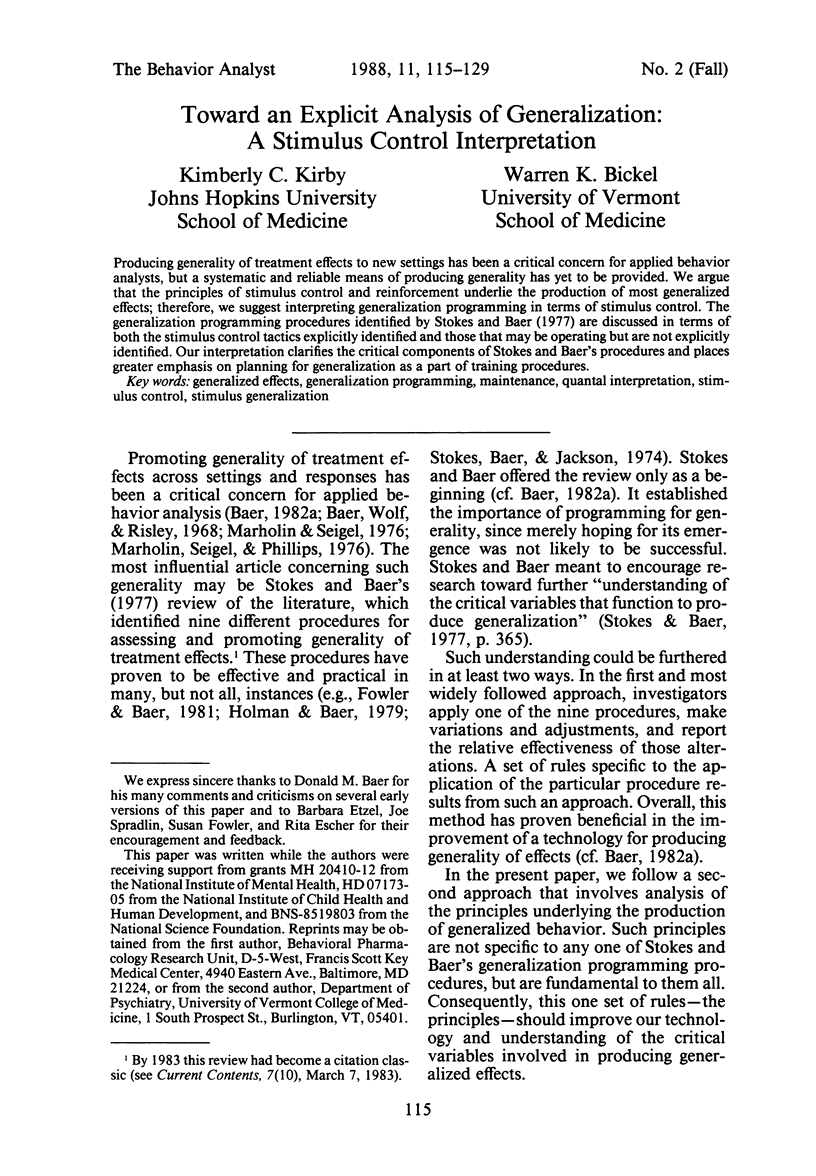
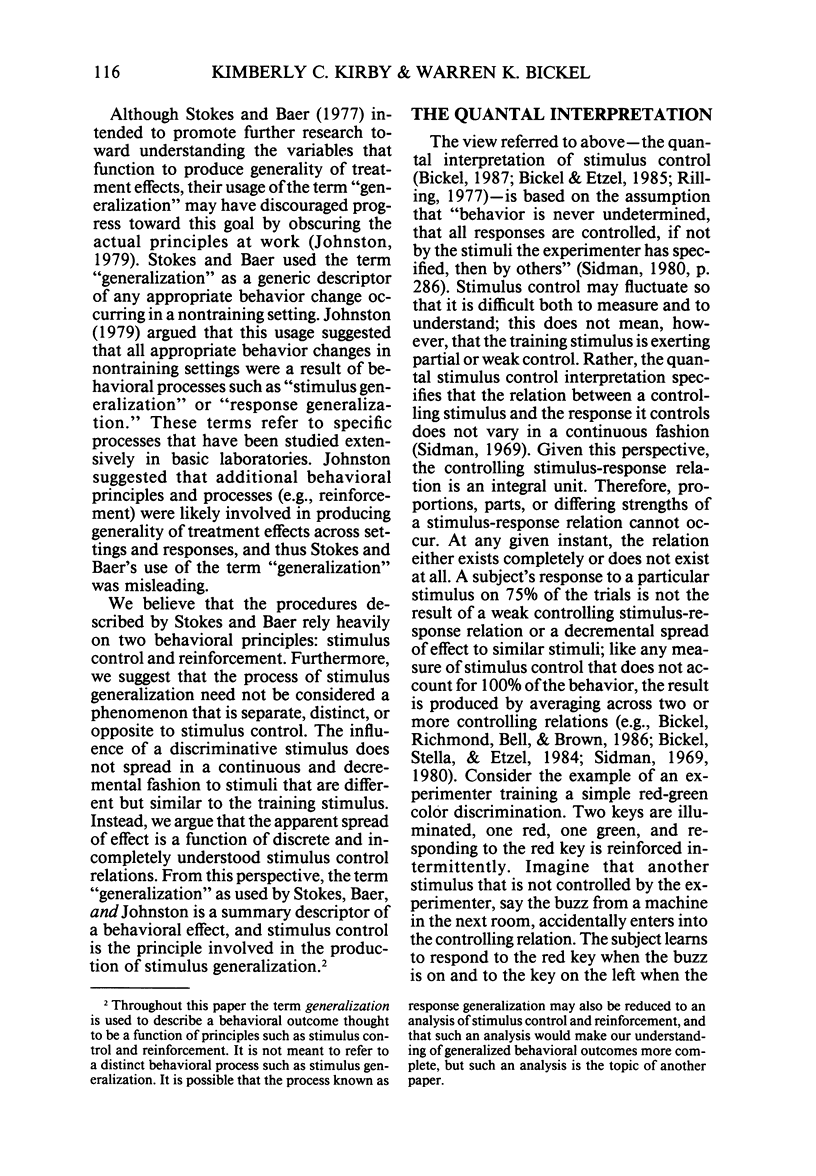
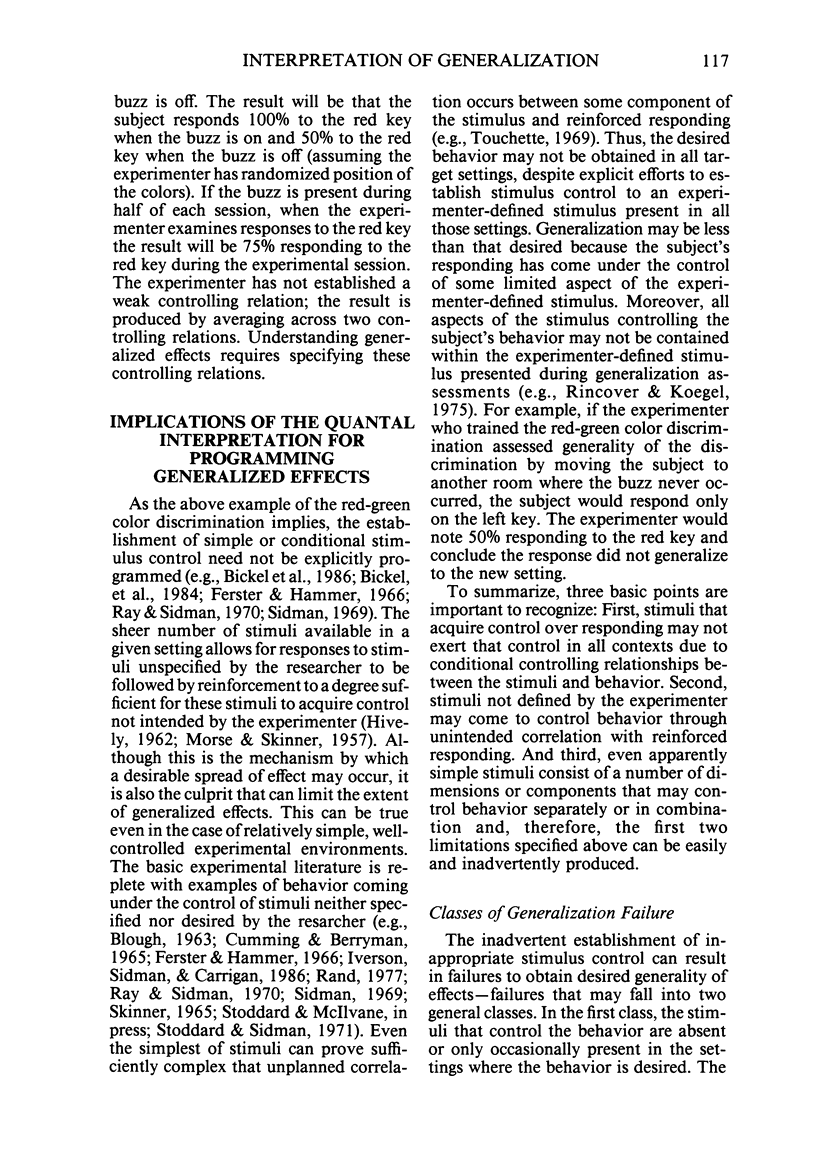
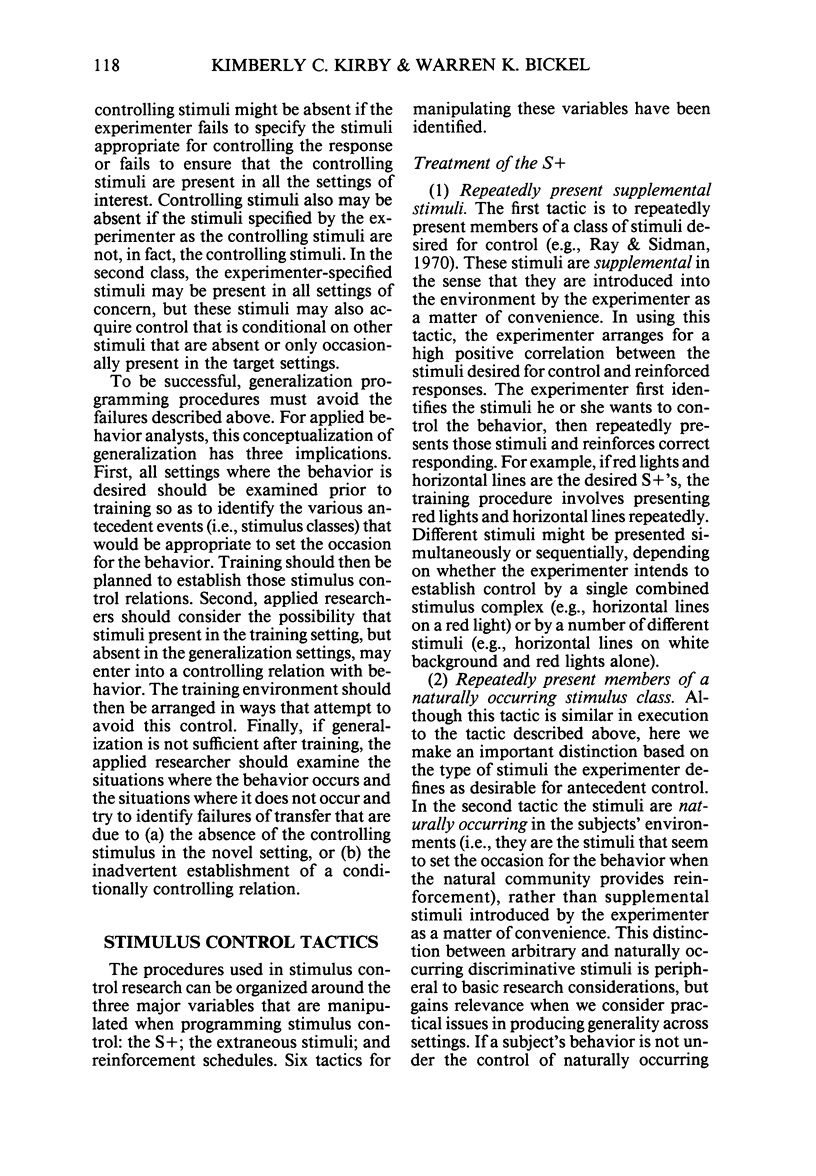
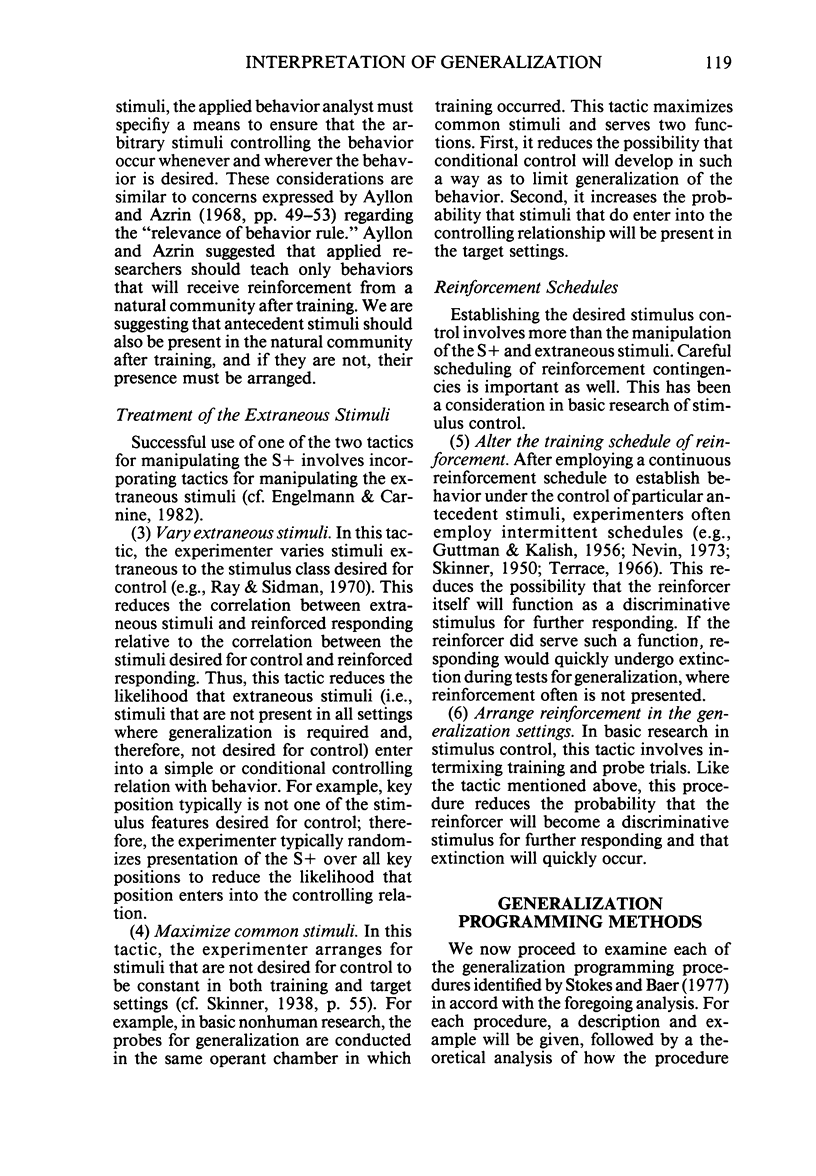
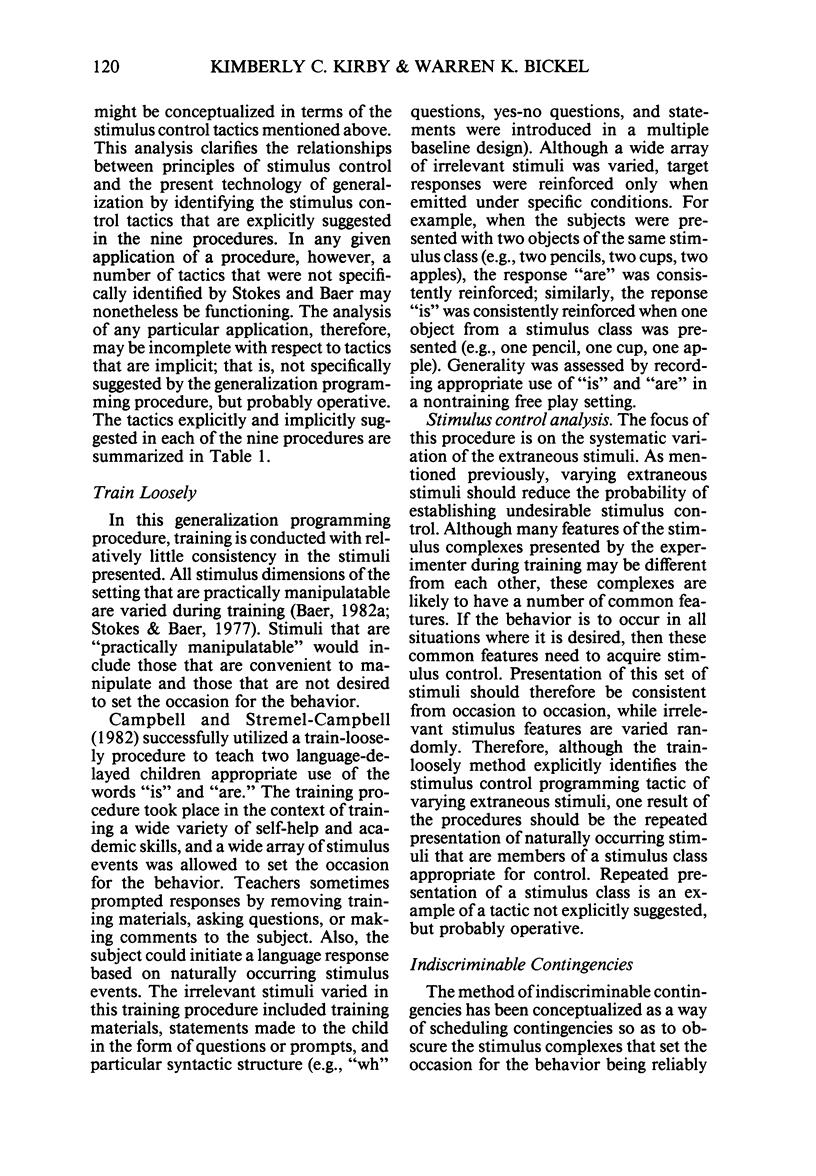
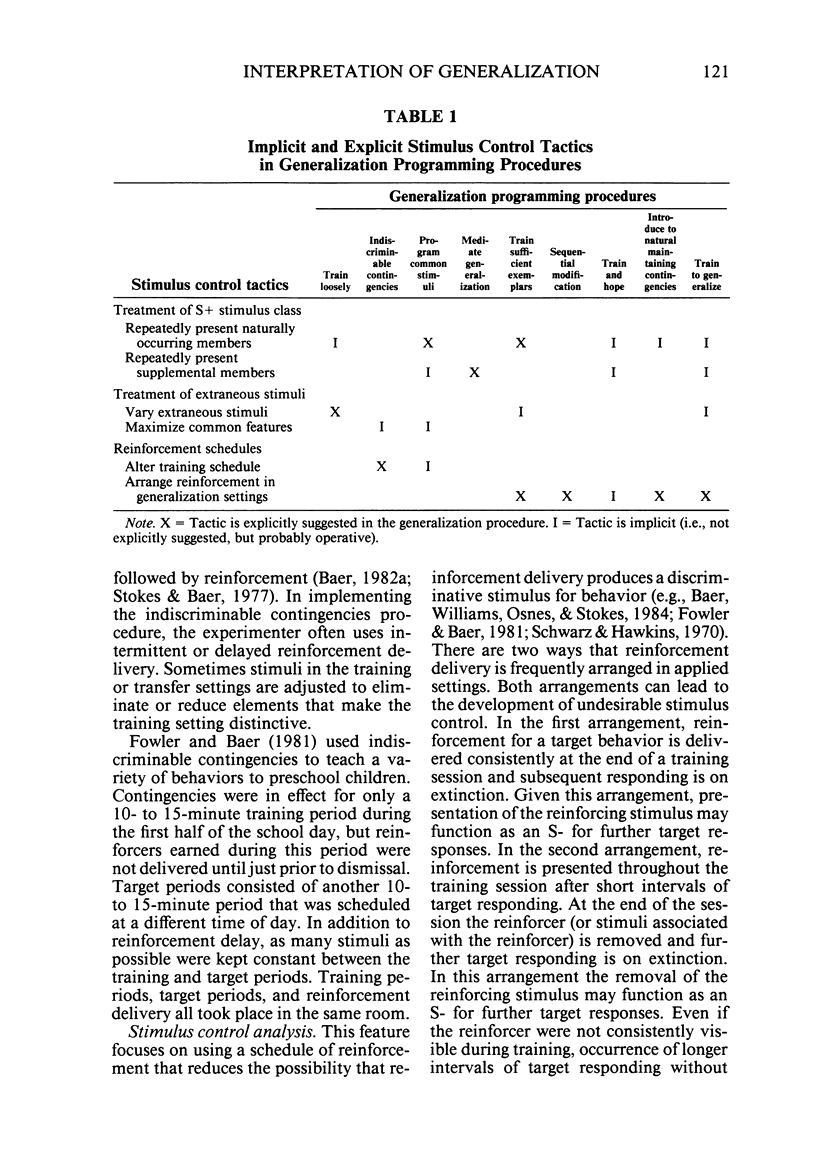
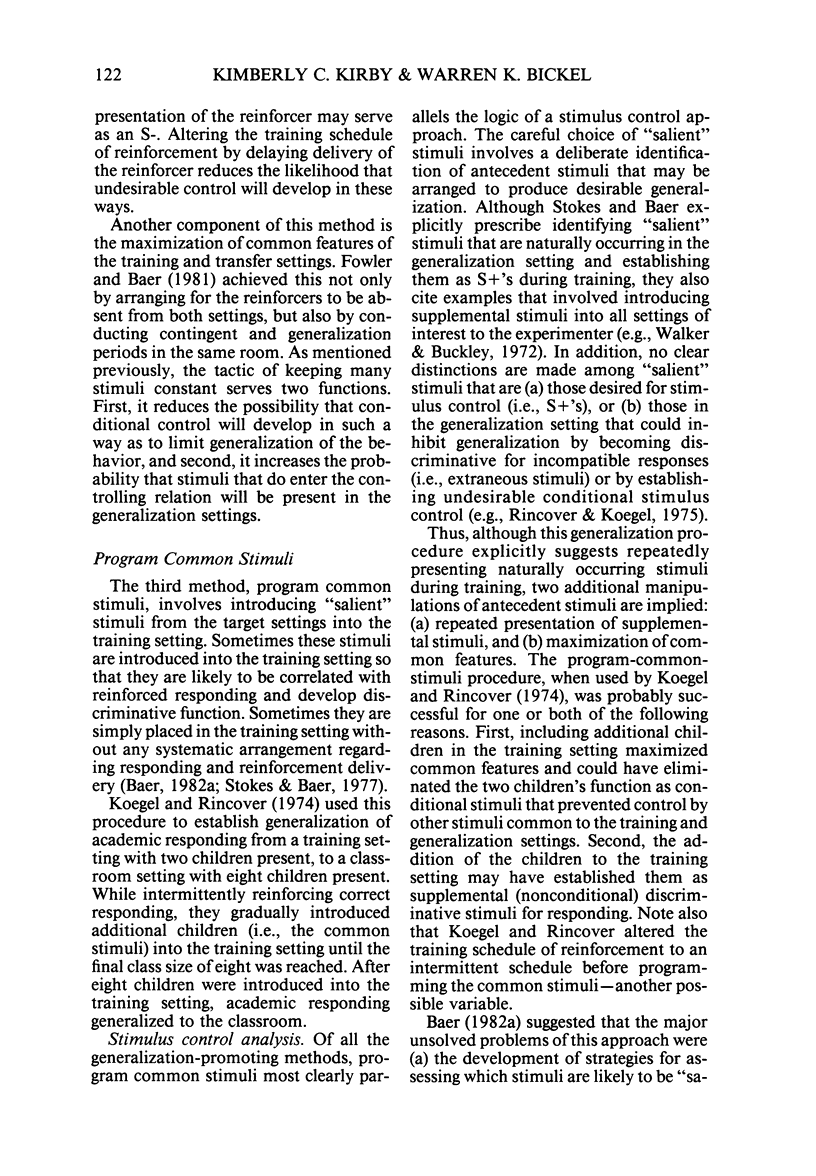
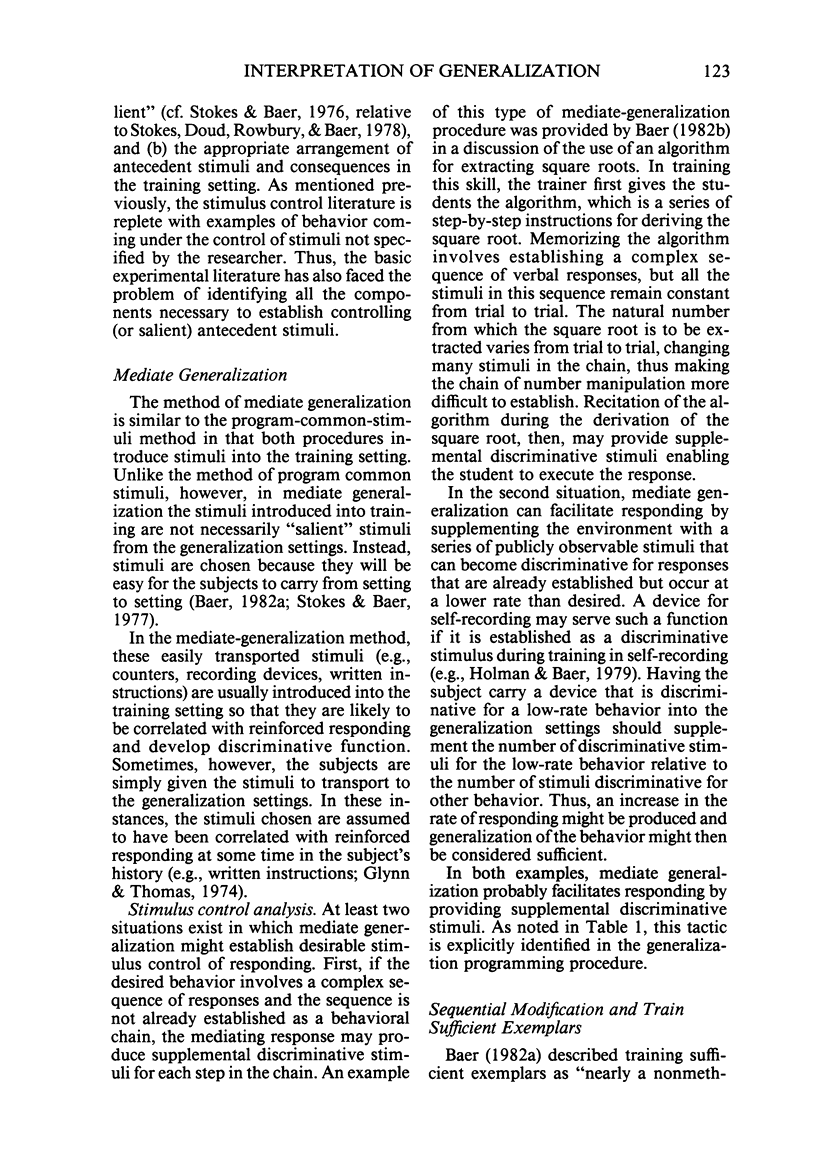
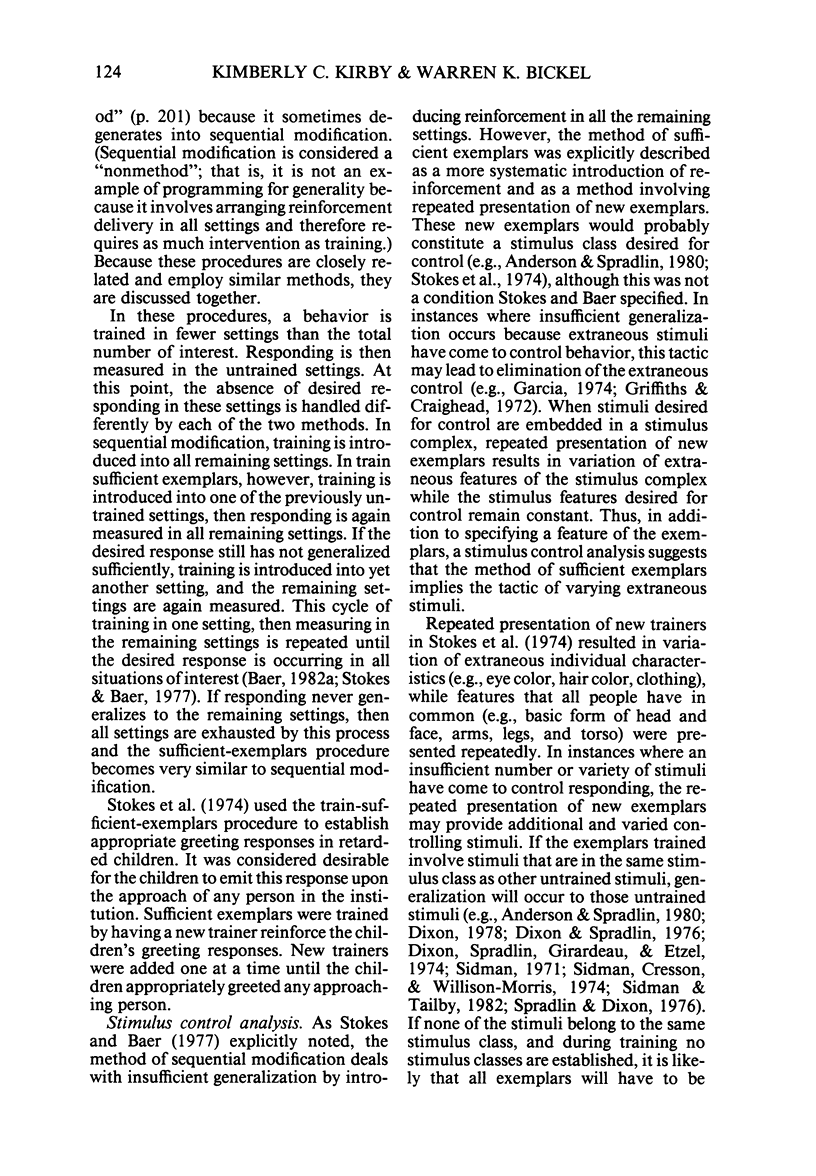
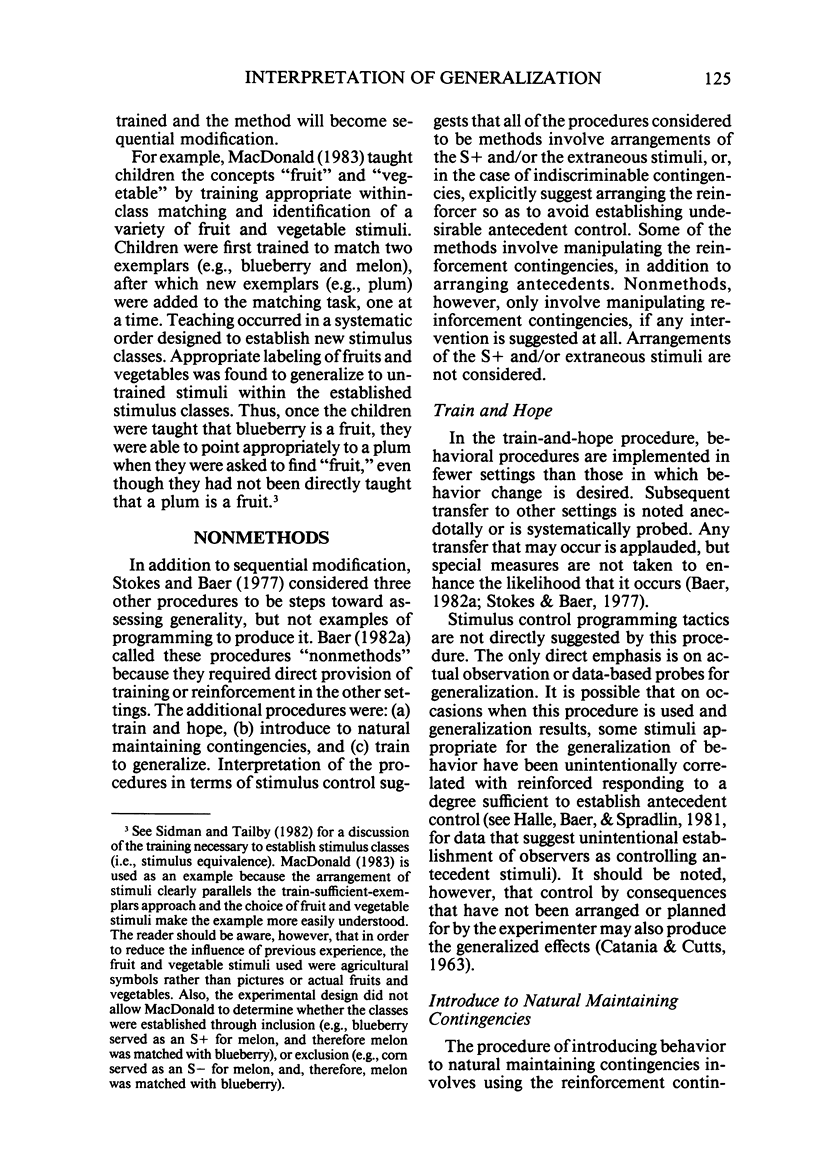
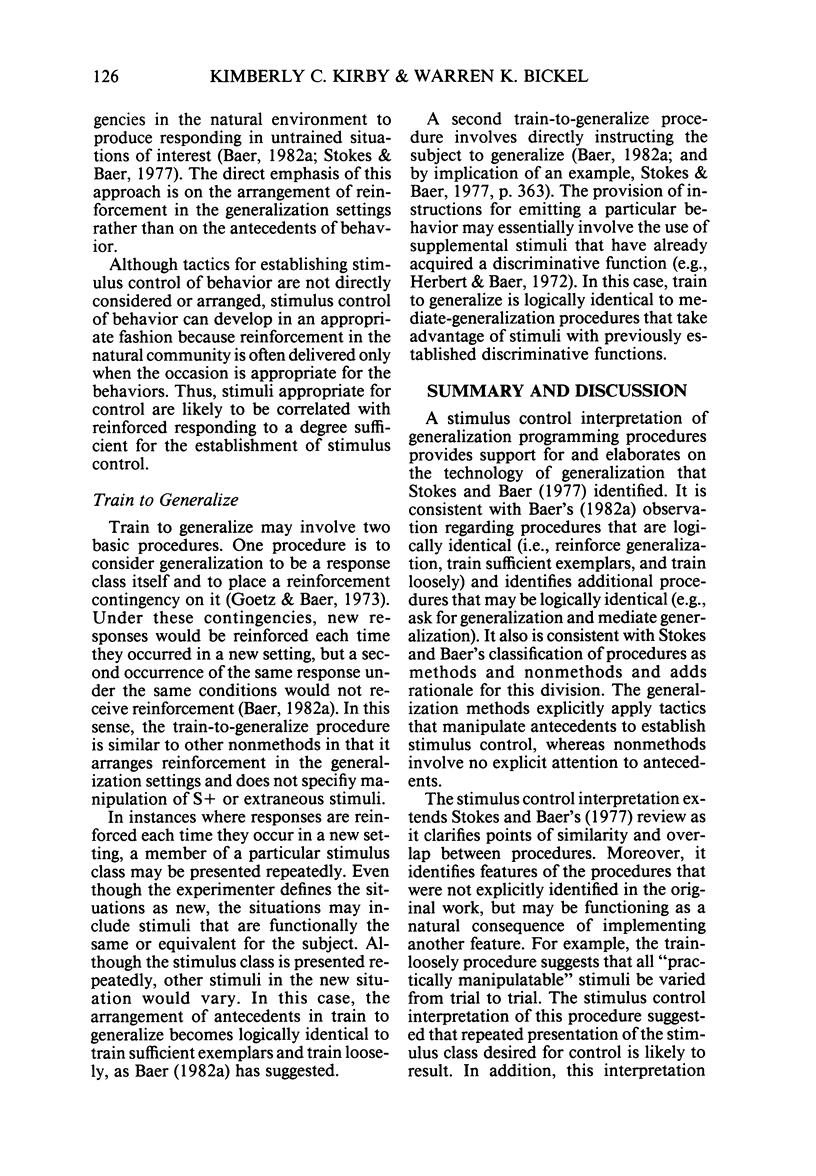
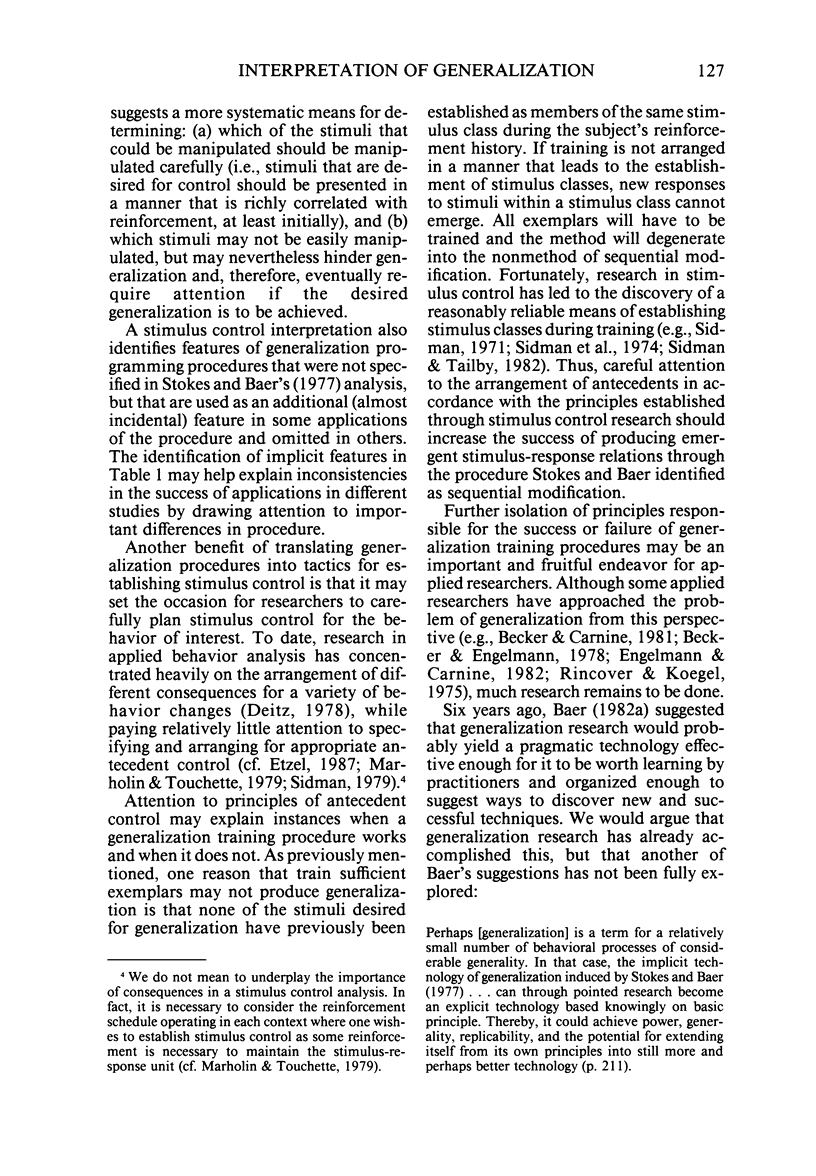
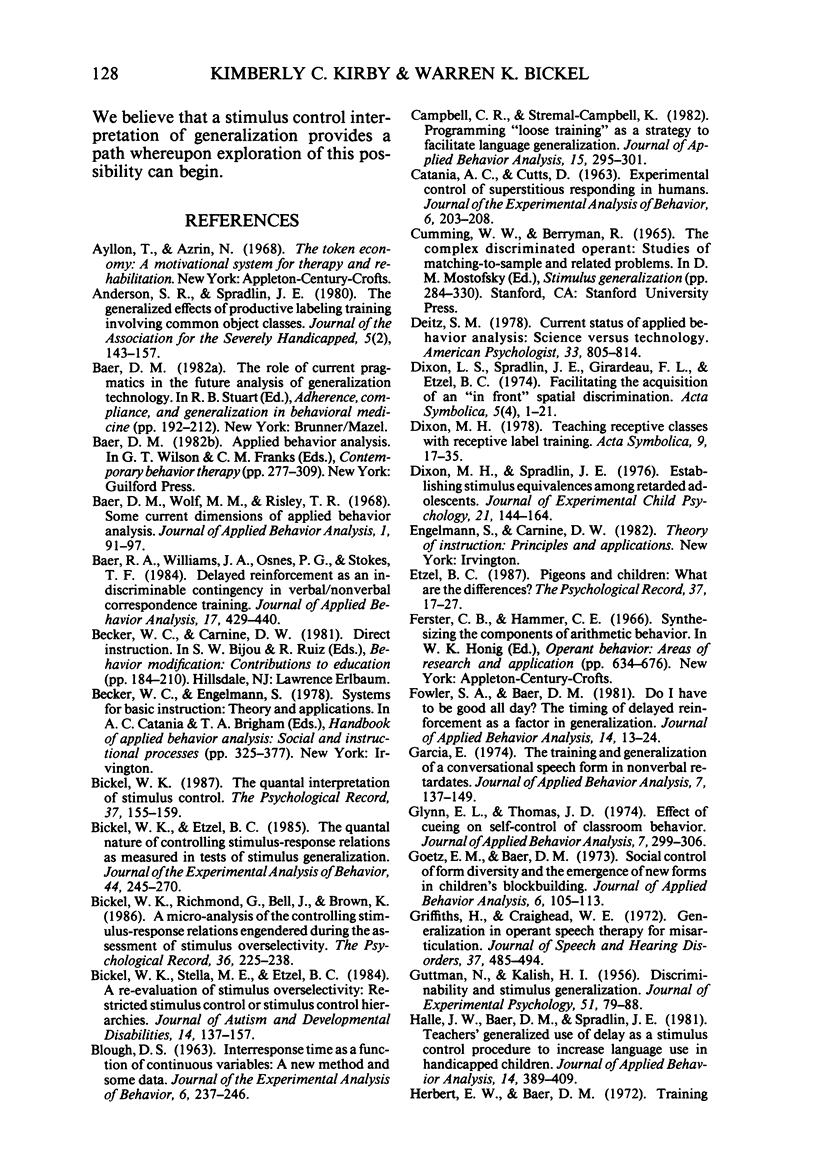
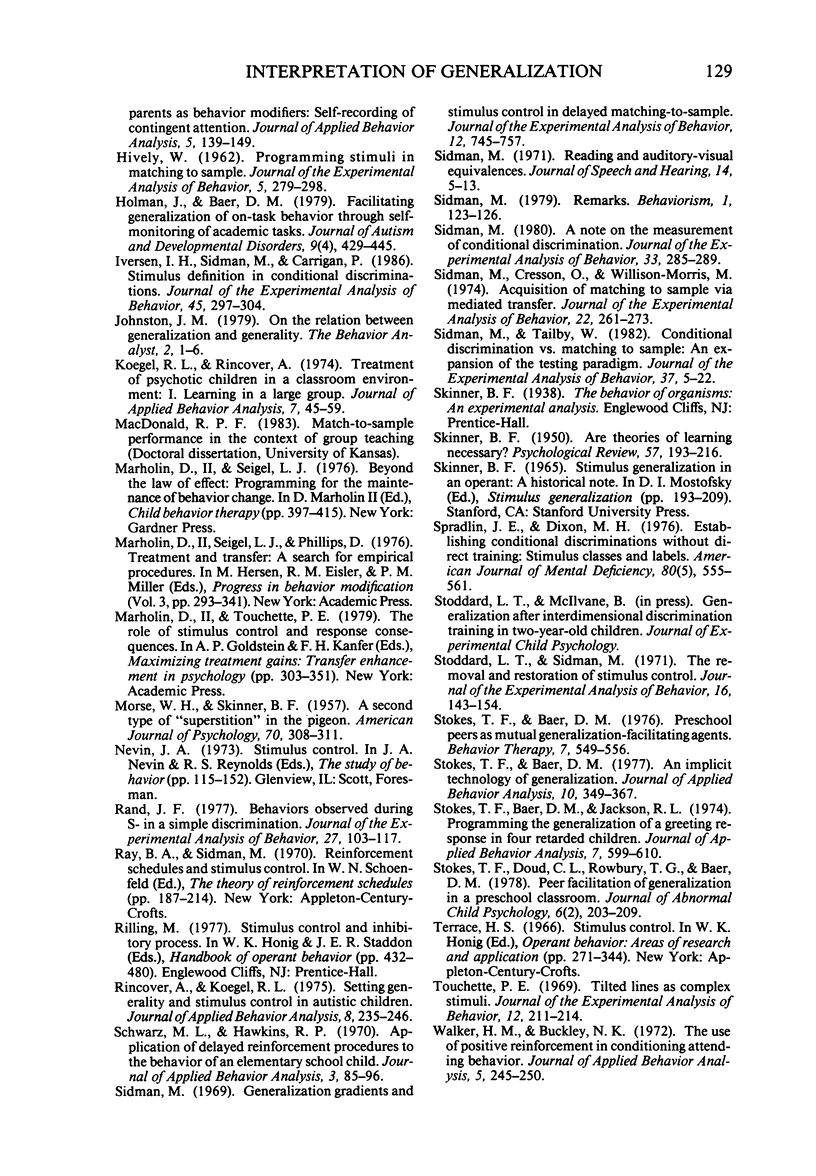
Selected References
These references are in PubMed. This may not be the complete list of references from this article.
- Baer D. M., Wolf M. M., Risley T. R. Some current dimensions of applied behavior analysis. J Appl Behav Anal. 1968 Spring;1(1):91–97. doi: 10.1901/jaba.1968.1-91. [DOI] [PMC free article] [PubMed] [Google Scholar]
- Baer R. A., Williams J. A., Osnes P. G., Stokes T. F. Delayed reinforcement as an indiscriminable contingency in verbal/nonverbal correspondence training. J Appl Behav Anal. 1984 Winter;17(4):429–440. doi: 10.1901/jaba.1984.17-429. [DOI] [PMC free article] [PubMed] [Google Scholar]
- Bickel W. K., Etzel B. C. The quantal nature of controlling stimulus-response relations as measured in tests of stimulus generalization. J Exp Anal Behav. 1985 Sep;44(2):245–270. doi: 10.1901/jeab.1985.44-245. [DOI] [PMC free article] [PubMed] [Google Scholar]
- Bickel W. K., Stella M. E., Etzel B. C. A reevaluation of stimulus overselectivity: restricted stimulus control or stimulus control hierarchies. J Autism Dev Disord. 1984 Jun;14(2):136–157. doi: 10.1007/BF02409657. [DOI] [PubMed] [Google Scholar]
- Blough D. S. Interresponse time as a function of continuous variables: a new method and some data. J Exp Anal Behav. 1963 Apr;6(2):237–246. doi: 10.1901/jeab.1963.6-237. [DOI] [PMC free article] [PubMed] [Google Scholar]
- CATANIA A. C., CUTTS D. Experimental control of superstitious responding inhumans. J Exp Anal Behav. 1963 Apr;6:203–208. doi: 10.1901/jeab.1963.6-203. [DOI] [PMC free article] [PubMed] [Google Scholar]
- Campbell C. R., Stremel-Campbell K. Programming "loose training" as a strategy to facilitate language generalization. J Appl Behav Anal. 1982 Summer;15(2):295–301. doi: 10.1901/jaba.1982.15-295. [DOI] [PMC free article] [PubMed] [Google Scholar]
- Dixon M., Spradlin J. Establishing stimulus equivalences among retarded adolescents. J Exp Child Psychol. 1976 Feb;21(1):144–164. doi: 10.1016/0022-0965(76)90064-3. [DOI] [PubMed] [Google Scholar]
- Fowler S. A., Baer D. M. "Do I have to be good all day? The timing of delayed reinforcement as a factor in generalization. J Appl Behav Anal. 1981 Spring;14(1):13–24. doi: 10.1901/jaba.1981.14-13. [DOI] [PMC free article] [PubMed] [Google Scholar]
- GUTTMAN N., KALISH H. I. Discriminability and stimulus generalization. J Exp Psychol. 1956 Jan;51(1):79–88. doi: 10.1037/h0046219. [DOI] [PubMed] [Google Scholar]
- Garcia E. The training and generalization of a conversational speech form in nonverbal retardates. J Appl Behav Anal. 1974 Spring;7(1):137–149. doi: 10.1901/jaba.1974.7-137. [DOI] [PMC free article] [PubMed] [Google Scholar]
- Glynn E. L., Thomas J. D. Effect of cueing on self-control of classroom behavior. J Appl Behav Anal. 1974 Summer;7(2):299–306. doi: 10.1901/jaba.1974.7-299. [DOI] [PMC free article] [PubMed] [Google Scholar]
- Glynn E. L., Thomas J. D., Shee S. M. Behavioral self-control of on-task behavior in an elementary classroom. J Appl Behav Anal. 1973 Spring;6(1):105–113. doi: 10.1901/jaba.1973.6-105. [DOI] [PMC free article] [PubMed] [Google Scholar]
- Griffiths H., Craighead W. E. Generalization in operant speech therapy for misarticulation. J Speech Hear Disord. 1972 Nov;37(4):485–494. doi: 10.1044/jshd.3704.485. [DOI] [PubMed] [Google Scholar]
- HIVELY W. Programming stimuli in matching to sample. J Exp Anal Behav. 1962 Jul;5:279–298. doi: 10.1901/jeab.1962.5-279. [DOI] [PMC free article] [PubMed] [Google Scholar]
- Halle J. W., Baer D. M., Spradlin J. E. Teachers' generalized use of delay as a stimulus control procedure to increase language use in handicapped children. J Appl Behav Anal. 1981 Winter;14(4):389–409. doi: 10.1901/jaba.1981.14-389. [DOI] [PMC free article] [PubMed] [Google Scholar]
- Holman J., Baer D. M. Facilitating generalization of on-task behavior through self-monitoring of academic tasks. J Autism Dev Disord. 1979 Dec;9(4):429–446. doi: 10.1007/BF01531449. [DOI] [PubMed] [Google Scholar]
- Iversen I. H., Sidman M., Carrigan P. Stimulus definition in conditional discriminations. J Exp Anal Behav. 1986 May;45(3):297–304. doi: 10.1901/jeab.1986.45-297. [DOI] [PMC free article] [PubMed] [Google Scholar]
- Johnston J. M. On the relation between generalization and generality. Behav Anal. 1979 Fall;2(2):1–6. doi: 10.1007/BF03391833. [DOI] [PMC free article] [PubMed] [Google Scholar]
- Koegel R. L., Rincover A. Treatment of psychotic children in a classroom environment: I. Learning in a large group. J Appl Behav Anal. 1974 Spring;7(1):45–59. doi: 10.1901/jaba.1974.7-45. [DOI] [PMC free article] [PubMed] [Google Scholar]
- MORSE W. H., SKINNER B. F. A second type of superstition in the pigeon. Am J Psychol. 1957 Jun;70(2):308–311. [PubMed] [Google Scholar]
- Rand J. F. Behaviors observed during S- in a simple discrimination learning task. J Exp Anal Behav. 1977 Jan;27(1):103–117. doi: 10.1901/jeab.1977.27-103. [DOI] [PMC free article] [PubMed] [Google Scholar]
- Rincover A., Koegel R. L. Setting generality and stimulus control in autistic children. J Appl Behav Anal. 1975 Fall;8(3):235–246. doi: 10.1901/jaba.1975.8-235. [DOI] [PMC free article] [PubMed] [Google Scholar]
- SKINNER B. F. Are theories of learning necessary? Psychol Rev. 1950 Jul;57(4):193–216. doi: 10.1037/h0054367. [DOI] [PubMed] [Google Scholar]
- Schwarz M. L., Hawkins R. P. Application of delayed reinforcement procedures to the behavior of an elementary school child. J Appl Behav Anal. 1970 Summer;3(2):85–96. doi: 10.1901/jaba.1970.3-85. [DOI] [PMC free article] [PubMed] [Google Scholar]
- Sidman M. A note on the measurement of conditional discrimination. J Exp Anal Behav. 1980 Mar;33(2):285–289. doi: 10.1901/jeab.1980.33-285. [DOI] [PMC free article] [PubMed] [Google Scholar]
- Sidman M., Cresson O., Jr, Willson-Morris M. Acquisition of matching to sample via mediated transfer. J Exp Anal Behav. 1974 Sep;22(2):261–273. doi: 10.1901/jeab.1974.22-261. [DOI] [PMC free article] [PubMed] [Google Scholar]
- Sidman M. Generalization gradients and stimulus control in delayed matching-to-sample. J Exp Anal Behav. 1969 Sep;12(5):745–757. doi: 10.1901/jeab.1969.12-745. [DOI] [PMC free article] [PubMed] [Google Scholar]
- Sidman M. Reading and auditory-visual equivalences. J Speech Hear Res. 1971 Mar;14(1):5–13. doi: 10.1044/jshr.1401.05. [DOI] [PubMed] [Google Scholar]
- Sidman M., Tailby W. Conditional discrimination vs. matching to sample: an expansion of the testing paradigm. J Exp Anal Behav. 1982 Jan;37(1):5–22. doi: 10.1901/jeab.1982.37-5. [DOI] [PMC free article] [PubMed] [Google Scholar]
- Spradlin J. E., Dixon M. H. Establishing conditional discriminations without direct training: stimulus classes and labels. Am J Ment Defic. 1976 Mar;80(5):555–561. [PubMed] [Google Scholar]
- Stoddard L. T., Sidman M. The removal and restoration of stimulus control. J Exp Anal Behav. 1971 Sep;16(2):143–154. doi: 10.1901/jeab.1971.16-143. [DOI] [PMC free article] [PubMed] [Google Scholar]
- Stokes T. F., Baer D. M. An implicit technology of generalization. J Appl Behav Anal. 1977 Summer;10(2):349–367. doi: 10.1901/jaba.1977.10-349. [DOI] [PMC free article] [PubMed] [Google Scholar]
- Stokes T. F., Baer D. M., Jackson R. L. Programming the generalization of a greeting response in four retarded children. J Appl Behav Anal. 1974 Winter;7(4):599–610. doi: 10.1901/jaba.1974.7-599. [DOI] [PMC free article] [PubMed] [Google Scholar]
- Stokes T. F., Doud C. L., Rowbury T. G., Baer C. M. Peer facilitation of generalization in a preschool classroom. J Abnorm Child Psychol. 1978 Jun;6(2):203–209. doi: 10.1007/BF00919125. [DOI] [PubMed] [Google Scholar]
- Touchette P. E. Tilted lines as complex stimuli. J Exp Anal Behav. 1969 Mar;12(2):211–214. doi: 10.1901/jeab.1969.12-211. [DOI] [PMC free article] [PubMed] [Google Scholar]


